Introduction to Pleached Trees
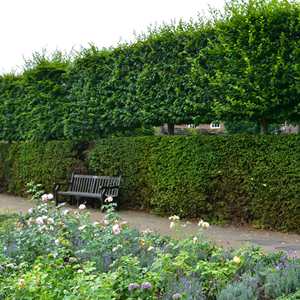
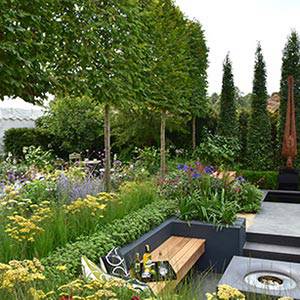
Pleached trees are trees that have been trained to form a stunning screen of branches and foliage on a single, straight stem. When they are planted in rows at set distances, they form an elevated 'green wall' effect, which can be a great, natural alternative to high fencing. Pleached trees are often used to screen unsightly buildings and can be grown above an existing wall or fence for added privacy. The stems of our pleached trees are generally between 1.8m and 2.2m tall, so when grown alongside walls and fences, the pleached trees can extend the height of a privacy screen by 3m or even more.
Sometimes known as 'hedges on stilts', or 'pleached hedging', the classic technique was used frequently in Medieval times, when it was used to create shaded walkways - known as pleached allées - traditionally using pleached Lime or Hornbeam trees. It was very popular in the 17th and 18th centuries, especially in France and Italy, where the trees could be seen lining the gardens of beautiful stately homes.
In recent years, pleached trees have seen renewed interest and are a firm favourite amongst RHS Chelsea Flower Show garden designers, who appreciate how the attractive trees work just as well in contemporary gardens.
Guide Content:
- Pleached Espalier Trees - How Do They Differ From Standard Pleached?
- Prices and Ordering
- Delivery of Pleached Trees and Espaliers
- Handling and Installation of Pleached Trees and Espaliers
- Which Trees are Best for Pleaching and Espaliering?
- How to Train Pleached Trees and Espaliers
- Planting Pleached Trees
- Pruning and Maintenance of Pleached Trees and Espaliers
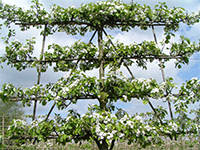
Pleached Espalier Trees
Pleached espaliers also have a straight stem that is around 2m above ground level. However, espaliers are trained into horizontal tiers, meaning that they look more uniform.
Espalier trees are usually trees that produce fruit or flowers, so having spaces between the tiers gives them plenty of room to flourish.
Prices and Ordering
The price of pleached trees varies depending on the species of tree and its stage of growth. Mature pleached trees are more expensive, due to the expert care and skill that has gone into crafting such beautiful trees.
If you're hoping to order a number of trees, we may be able to offer a discount, so we would recommend giving Hedges Direct a call on 01257 494 097 or requesting a call back on [email protected] - just make sure to make your phone number the subject line of your email, and we'll get back to you within 15 minutes if you email during our opening hours.
The Hedges Direct team are experts in pleached trees, so we will be happy to help with any questions or enquiries that you might have.
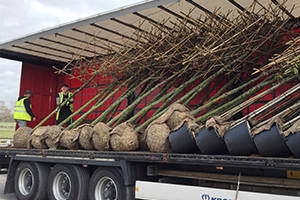
Delivery of Pleached Trees and Espaliers
You can order any quantity of pleached trees, but for orders of 4 trees or below, please note that a delivery charge will apply. For larger orders, we can often subsidise the delivery cost or discount the cost of the plants.
It is a little challenging delivering pleached trees, but thankfully we have years of experience getting them safely to gorgeous gardens across the country, so whether your outdoor space is small, stately or suburban, we are happy to take on the challenge. Our pleached trees are mainly grown as root balls, so the season typically runs from October to May. We do have a range of pot-grown pleached trees available all year round - fresh pleached trees in particular are a cost-effective and popular option.
If you are ordering online, please note that most pleached trees as a single unit will exceed the standard threshold for free delivery via a lorry or pallet. Due to their size, shape and weight, pleached trees require specialist delivery via an articulated lorry, so we'll need to speak with you to arrange delivery and to make sure we can get access to your property to carry out the delivery. If there are access issues, we can try using a smaller vehicle, but that involves double handling from us, so we would need to quote you for a delivery supplement. If this is the case, get in touch with us for a quote.
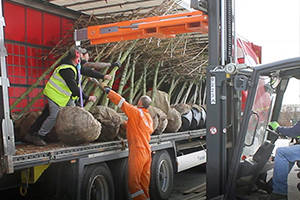
Handling and Installation of Pleached Trees and Espaliers
Please bear in mind that most of these trees are very tall and heavy, so will require specialist machinery to remove from the delivery lorry and to move into place for planting. For all deliveries, you should make sure there is enough support at your end to help the driver to take the plants off the lorry. Two able-bodied helpers would be enough to support the delivery of younger trees, whereas for more mature pleached trees, four helpers - and preferably a forklift - will be required.
We can't guarantee what time in the day your trees will arrive, so we would recommend that you book any lifting and moving equipment for a full day, just so you can avoid any issues if they arrive earlier or later than planned.
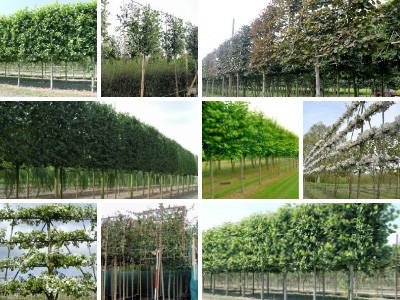
Which Trees are Best for Pleaching and Espaliering?
Traditionally, Lime, Beech and Hornbeam trees have been a popular choice for pleaching, and today they are still some of the most commonly-used trees. For something a bit different, Hedges Direct also offers Field Maple, London Plane, Cherry Laurel and Photinia pleached trees.
The best trees for pleaching must have relatively short distance between the buds, to give the density of branches required for this technique. They must also be robust enough to resist disease - pleached trees need to be pruned regularly, which leaves wounds that have the potential for infection until they have fully healed. For this reason, Horse Chestnut, Birch and Cherry trees aren't suitable for pleaching.
The best species for growing pleached espaliers are members of the apple and pear families, such as Crab Apple and Ornamental pear trees, which are available to buy on the Hedges Direct website.
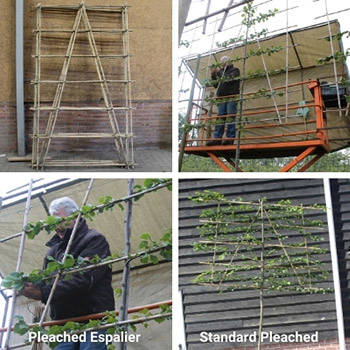
How to Train Pleached Trees and Espaliers
It is possible to pleach your own trees from scratch if you have a young plant. You will need to go for straight, tall, bare root trees with a girth of around 8 - 10cm, or, ideally a 10-12cm girth.
Pleached trees are trained by creating a rectangular framework of bamboo in the 'head' of the tree for the branches to grow along, to form a screen effect. The frame is securely fastened to the trunk and to the central stem of the head and then the side branches - also known as laterals - are very carefully bent downwards and tied into the horizontal bamboo framework.
Just to note, this can only be done with very young branches, as thicker and more mature wood will resist being bent and may snap under pressure. There is no set distance required between the laterals, so just make sure they are tied in where they fit best, as long as they are not crossing each other. Smaller shoots or sub-laterals can be tied in at any angle or position, as long as the overall shape of the tree is maintained.
Traditionally, the height of the bamboo frame is between 1.5m and 2m, which can give an overall tree height of up to an impressive 4m. The width of a frame on a young tree will also be 2m, but as the tree starts to grow this can be increased with further training to a width between 3m to 5m. You'll need to make sure the mature size of the tree is considered when planting your pleached trees, to make sure there's enough space between them.
For pleached espalier trees, training is normally carried out on apple, pear and other fruit trees that produce flowering and fruiting buds. Unlike standard pleaching, espaliers have formalised, regular spacing between the horizontal branches of the trees, known as tiers. The spacing between tiers is typically around 20cm, as this allows for maturing fruit to get air and sunlight which, in turn, reduces the potential for disease and improves the sweetness of the fruit. Espaliers can have any number of tiers, with a new tier trained in each season until the desired height is reached.
Espaliers must be pruned more routinely than pleached trees, so they don't make a full 'green screen', but they do have the advantage of bearing lovely flowers and fruit.
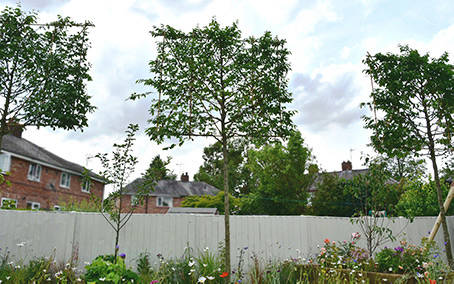
Planting Pleached Trees
The planting distance of pleached trees depends on a few factors, such as which species of tree you have opted for, and the desired final look that you are aiming for. The trees can be planted so that each screen is just touching, although we would advise leaving at least a few feet between them to allow for growth, as this will give a deep, bushy screen effect.
Depending on your patience - and your budget - you could try planting the trees with up to 10-12 feet between the widest parts of the screens, as over time, the branches will grow out to meet the other trees, creating an elegant, narrow screening effect.
When it comes to considering the best distance from a building to plant the trees, this is dependent on the type of tree you choose. For example, Crab Apple trees have a lesser root spread than Platanus. It is best to call your insurance provider who will be able to advise further if you have any concerns about planting pleached trees.
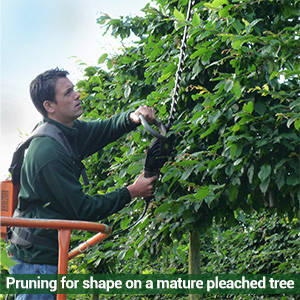
Pruning and Maintenance of Pleached Trees and Espaliers
When it comes to pruning and maintaining pleached trees, it can help to think of it as a two-stage process:
Stage 1 - involves pruning to train and tie in a pleached tree that is being started from scratch, is called 'formative' pruning.
Stage 2 - is the pruning that is required to maintain the shape and form of a more mature pleached tree, and is known as 'pruning for shape'.
In formative pruning, as the young laterals - also known as secondary branches - are bent downwards and tied in to the bamboo framework, any excess laterals and stronger sub-laterals that are not growing in the plane of the tree should be pruned back to within a few centimetres of the stem. Any branches that are growing above the required overall height should be cut back to just below the top of the frame.
Any branches that are crossing each other should be removed. This is because the branches can rub against each other, potentially causing wounds that can lead to disease entering the tree. You should tie in the branches with soft twine or plastic ties to avoid cutting into the tree. If you have a more mature pleached tree, you should check the ties regularly and replace them if they are too tight, as they can cut into the tree as the branches start to thicken.
Tying in and formative pruning should be done several times during the growing season, with the final prune in October. When pruning to maintain the shape of a pleached tree, you should first remove any diseased or damaged wood and broken branches, before pruning the tree into the desired shape. It's quite a low-maintenance process as it only needs to be done once or twice a year - late winter can be a good time to do this, as you can assess any winter damage and trim the tree before the leaves grow back in spring.
Once you have an established and mature pleached tree, you can cut away the old bamboo framework, to show your pleached trees in their full glory. Many of the pleached trees for sale on Hedges Direct are already at this stage of their development, having been trained and nurtured to grow into mature pleached trees, meaning that all of the hard work has already been done for you - you can just sit back and admire the ready-grown trees.
Espaliers require a slightly more formal approach to pruning. The tiers are trained at regular spacings and each winter, all branches that are growing upwards will need to be cut back to around 5cm to form 'spurs' that will bear blossom and fruit the following year. Each tier of your pleached espalier tree can be extended until the tree is as wide as you would like it to be. Hedges Direct has a range of beautiful pleached fresh and mature espaliers that are ready for you to enjoy.
If you'd like to browse our range of pleached trees, we have options available to suit gardens of every style. Alternatively, if you'd like to speak to our experts, just give us a call on 01257 494 097 and they will be happy to help.
 Hedges Direct
Hedges Direct 



